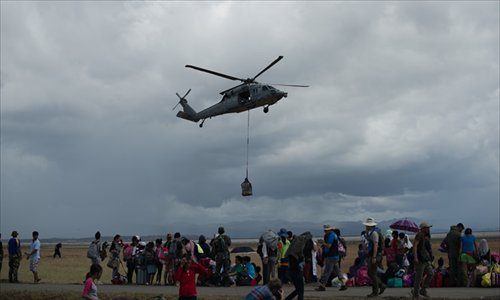Additional aid ‘matched situation’

Local residents watch as a US navy helicopter delivers relief supplies at Tacloban airport on Thursday. Scores of decaying bodies were being taken to mass graves as overwhelmed Philippine authorities grappled with disposal of the dead and the living begged for help in the aftermath of the disaster. Photo: AFP
China's foreign ministry said on Thursday that the Chinese people are saddened by the huge losses the Philippines has suffered as a result of the strongest typhoon ever recorded, and that China is willing to provide humanitarian aid to the Philippines within its capabilities.
Super Typhoon Haiyan had caused more than 2,300 deaths in the Philippines as of Thursday, according to Philippine officials.
China had donated relief supplies including tents and blankets, which were valued at 10 million yuan ($1.64 million) in addition to the previous monetary aid of $100,000 from the Chinese government and another $100,000 from the China Red Cross Society, Chinese foreign ministry spokesman Qin Gang said at a regular press briefing.
The aid would continue to be changed and adjusted in accordance with the needs of the Philippines, Qin said in reaction to a question on why China sent additional aid.
International relief efforts have been gaining pace. The Philippine Department of Foreign Affairs said on Wednesday that it has received assistance from 36 countries and regions as well as international organizations worth $89.5 million in total, and extended the government's gratitude to the donors, the Xinhua News Agency reported.
The UK will send its largest ship, helicopter carrier HMS Illustrious, to help with relief work, British Prime Minister David Cameron said on Thursday.
In the meantime, Hong Kong vowed on Thursday to press ahead with sanctions on Manila over a 2010 hostage crisis in which eight Hong Kongers were killed. The decision triggered outrage among some Hong Kong people and Filipino workers in the city.
Despite the increasing international aid, desperate survivors still lack basic supplies such as food, water and medicine almost a week after the devastating storm made landfall.
"I do feel that we have let people down," said the UN humanitarian aid chief Valerie Amos.
The US said relief channels were belatedly opening up to the ravaged regions on Thursday. Meanwhile, a US aircraft carrier arrived on Thursday as part of an emergency aid mission.
The USS George Washington, with 5,000 crew and more than 80 aircraft aboard, headed an eight-strong flotilla of US vessels carrying equipment, supplies and expertise for the displaced by the storm.
The commanding general of the Third Marine Expeditionary Brigade in Japan, Marine Brigadier General Paul Kennedy, said the US relief effort was being strengthened to a level that has "probably never been applied" to a humanitarian event, BBC reported.
The US is now mainly focused on helping its ravaged ally with relief work, though the massive aid will surely help its Asia-Pacific rebalancing strategy, Ni Feng, deputy director of the Institute of American Studies at the Chinese Academy of Social Sciences, told the Global Times on Thursday, noting that the US also wants to have a larger profile in the region.
Unlike previous relief operations, the amphibious ships going to the Philippines carried several officers from Japan's Self-Defense Forces, which shows the cooperation between Japan and the US in such large-scale military and relief operations, a US diplomat in Manila, who refused to be named, told the Global Times on Thursday.
Japan has been ready to send as many as 1,000 self-defense troops together with naval vessels and aircraft, which marks the country's biggest military deployment since World War II.
A diplomatic source in Manila told the Global Times on Thursday that Tokyo had proposed directly to Aquino to add troops to the Philippines. While Aquino had just hoped to get more relief supplies and funds from Japan and personnel support from Southeast Asian countries, the Japanese government insisted on an increase of both monetary and personnel aid, with more manpower aid as a precondition for other relief efforts, hence the final deployment of 1,000 troops,.
Li Haidong, an associate professor with the Institute of International Relations at China Foreign Affairs University, said that the US and Japan may have more intentions hidden behind the humanitarian aid.
"With the aid provided, Japan partly aims to help the US carry out its pivot to Asia strategy; meanwhile the US can maintain its good relations with the Philippines and hence obtain support from the ally later in its pivot strategy," Li said.
Agencies contributed to this story